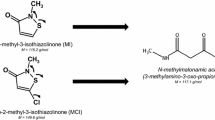Summary
35S-Cloxacillin was administered orally, intravenously or by intrajejunal instillation to healthy subjects. An oral dose of the35S-penicilloic acid of cloxacillin was given to two subjects. The absorption of radioactive material from the upper part of the digestive tract was calculated by reference to an unabsorbed marker in the test solution. After an oral dose of35S-cloxacillin, the average cumulative absorption of radioactivity from the upper jejunum was 60%, and although some35S-cloxacillin was degraded in the stomach, the uptake of radioactivity appeared mainly to represent absorption of intact drug. The uptake of radioactivity after administration of35S-penicilloic acid was about 30% of that of labelled cloxacillin. After35S-cloxacillin, up to 25% of radioactivity in urine and about 80% of that in bile were attached to microbiologically inactive cloxacillin metabolite(s). The almost identical pattern of degradation after oral and intravenous administration of35S-cloxacillin suggested that the metabolite(s) were formed outside the gastrointestinal tract. A comparison of the concentration of total cloxacillin equivalents (measured as total radioactivity) and intact cloxacillin (determined by microbiological assay) showed that a substantial part of the plasma radioactivity represented microbiologically inactive metabolites of cloxacillin. The half-life of the plasma label was much longer than that reported for the microbiologically active compound.
Similar content being viewed by others
Rèferences
Bray, G.B.: A simple efficient liquid scintillator for counting aqueous solutions in liquid scintillation counter. Analyt. Biochem.1, 279–285 (1960)
Bunn, P.A., Milicich, S.: Laboratory and clinical studies with cloxacillin. Antimicrob. Agents Chemother 220–226 (1963)
Floch, M.H.: Recent contributions in intestinal absorption and malabsorption. Amer. J. clin. Nutr.22, 327–351 (1969)
Fordtran, J.S.: Marker perfusion techniques for measuring intestinal absorption in man. Gastroenterology51, 1089–1093 (1966)
Gloxhuber, C., Offe, H.A., Rauenbusch, E., Scholtan, W., Schmid, J.: Dicloxacillin. Arzneimittel-Forsch.15, 322–330 (1965)
Gravenkamper, C.F., Sweedler, D.R., Brodie, J.L., Sidell, S., Kirby, W.M.M.: Cloxacillin: Comparison of oral and parenteral forms with oxacillin and methicillin. Antimicrob. Agents Chemother 231–236 (1963)
Grove, D.C., Randall, W.A.: Assay methods of antibiotics. A laboratory manual. New York: Medical Encyclopedia, Inc. 1955
Hou, J.P., Poole, J.W.: β-Lactam antibiotics: their physicochemical properties and biological activities in relation to structure. J. pharm. Sci.60, 503–532 (1971)
Hydén, S.: A turbidimetric method for the determination of higher polyethylene glycols in biological materials. Kungliga Lantbrukshögskolans Annaler22, 139–145 (1955)
Jeffay, H., Olubajo, F.O., Jewell, W.R.: Determination of radioactive sulphur in biological materials. Anal. Chem.32, 306–308 (1960)
Knudsen, E.T., Brown, D.M., Rolinson, G.N.: A new orally effective penicillinase-stable penicillin — BRL 1621. Lancet1962 II, 632–634
Kulhánek, M., Tadra, M.: Products of acylase and β-lactamase hydrolysis of some penicillins. Folia microbiol. (Praha)2, 340–345 (1968)
McGilveray, I.J., Strickland, R.D.: Detection and separation of penicillins by thin layer chromatography. J. pharm. Sci.56, 77–79 (1967)
Modr, Z., Dvořáček, K.: Kinetics of isoxazolylpenicillins. Review of Czechoslovak Medicine15, 79–91 (1969)
Murakawa, T., Wakai, Y., Nishida, M.: Chromatographic assay of mixed penicillins, ampicillin and cloxacillin in body fluids. J. Antibiot. (Tokyo)23, 250–251 (1970)
Nosslin, B.: The direct diazo reaction of bile pigments in serum. Scand. J. clin. Lab. Invest.49, 1–176 (1960)
Rolinson, G.N., Batchelor, F.R.: Penicillin metabolites. Antimicrob. Agents Chemother. 654–660, 1962
Rosenblatt, J.E., Kind, A.C., Brodie, J.L., Kirby, W.M.M.: Mechanisms responsible for the blood level differences of isoxazylol penicillins. Arch. int. Med.121, 345–348 (1968)
Sidell, S., Burdick, R.E., Brodie, J.L., Bulger, R.J., Kirby, W.M.M.: New antistaphyloccal antibiotics. Arch int. Med.112, 21–28 (1963)
Sutherland, R., Croydon, E.A.P., Rolinson, G.N.: Flucloxacillin, a new isoxazylol penicillin, compared with oxacillin, cloxacillin and dicloxacillin. Brit. med. J.1970 4, 455–460
Author information
Authors and Affiliations
Rights and permissions
About this article
Cite this article
Hellström, K., Rosén, A. & Swahn, A. Fate of oral35S-cloxacillin in man. Eur J Clin Pharmacol 7, 125–131 (1974). https://doi.org/10.1007/BF00561326
Received:
Issue Date:
DOI: https://doi.org/10.1007/BF00561326




